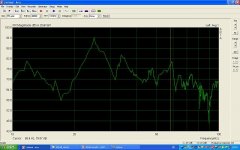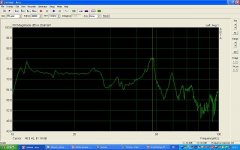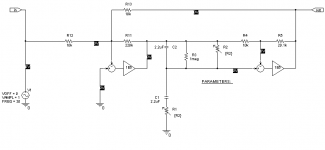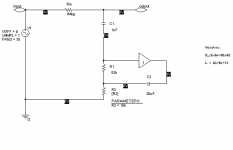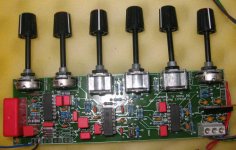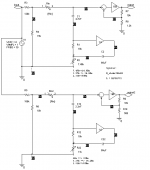Background: Most listening rooms show catastrophic resonance due to their parallel walls. Unfortunately normal room size result in 3 main resonances which are all in the range of normal music bass.
I was already struggling since long time with a 60Hz resonance, which was caused by the 3m distance between ceiling and floor. After quite some experiments I found a resonable placement for the subs....
But there are still some booming resonances. Today I got angry enough to tackle this with some more efforts.
I love controlled strong bass, but no annoying booming.
I found:
....yes, still some peak at 59Hz...
and "uahuuuu" quite some peak at 24.9 Hz.
Furtheron 34.1 Hz and about 50Hz.
The 24.9Hz is perfectly fitting to the two horizontal main resonances of the room (7.2m x 7.3m).
The 50Hz is the 2nd mode of the 24.9Hz resonance.
Here the measurement at my normal listening position.
I was already struggling since long time with a 60Hz resonance, which was caused by the 3m distance between ceiling and floor. After quite some experiments I found a resonable placement for the subs....
But there are still some booming resonances. Today I got angry enough to tackle this with some more efforts.
I love controlled strong bass, but no annoying booming.
I found:
....yes, still some peak at 59Hz...
and "uahuuuu" quite some peak at 24.9 Hz.
Furtheron 34.1 Hz and about 50Hz.
The 24.9Hz is perfectly fitting to the two horizontal main resonances of the room (7.2m x 7.3m).

The 50Hz is the 2nd mode of the 24.9Hz resonance.
Here the measurement at my normal listening position.
Attachments
...if you measure in the middle of the room, all main modes should cancel out...
YES! Wow, practice and theory are fitting together
Even more the 2nd modes will be max in this point and again YES, at least the double of the 24.9Hz resonances become very dominant and cause an ugly peak at 48-49Hz.
YES! Wow, practice and theory are fitting together
Even more the 2nd modes will be max in this point and again YES, at least the double of the 24.9Hz resonances become very dominant and cause an ugly peak at 48-49Hz.
Attachments
Up to now I could not figure out the reason for the 34.1Hz resonance. It does not fit to any obvious geometric property of my room and also not to the resonance of the subs. 
Anyway... I think I will put my class D amp short time on hold and will settle my bass system at least somehow reasonable. Means I will fit a proper LT ... AND now the topic of the thread: SOME NOTCH FILTERS !
There are two common circuitries which seem to be well suited: The WienRobinsonNotchFilter and the GyratorNotchFilter. ( BTW: JensRasmussen and ACD have a very nice Tutorial about active filters on their WebPage).
The WienRobinson would theoretically offer very nice performance allowing any Q, any f, any bandwidth... hey even a -80db notch with 3Hz bandwith. Well, unfortunately only if you have perfect components.
Some capacitor matching is easy, but the Wien Robinson is demanding two pots, which are perfectly identically.
Unfortunately even good real life tandem potis do easily show 10% mismatch (0.xx db). And with this the performance of the WienRobinson Filter is becoming poor.
On the other hand the GyratorNotchFilter is ending up in quite unpleasant values for the caps. I.e something like 10uF...33uF film caps, if you tackle 20Hz. Also the bandwith and Q will change if you only adjust the gyrator to different L values...
Means both solutions seem to have their limitations.
In the moment I am tending to go for the gyrator solution and settle two pots, one for the frequency and one for Q.
What are your real life experiences with DIY notch filters?
Your infos would be valuable for me to avoid at least the traditional pitfalls.....

Anyway... I think I will put my class D amp short time on hold and will settle my bass system at least somehow reasonable. Means I will fit a proper LT ... AND now the topic of the thread: SOME NOTCH FILTERS !
There are two common circuitries which seem to be well suited: The WienRobinsonNotchFilter and the GyratorNotchFilter. ( BTW: JensRasmussen and ACD have a very nice Tutorial about active filters on their WebPage).
The WienRobinson would theoretically offer very nice performance allowing any Q, any f, any bandwidth... hey even a -80db notch with 3Hz bandwith. Well, unfortunately only if you have perfect components.
Some capacitor matching is easy, but the Wien Robinson is demanding two pots, which are perfectly identically.
Unfortunately even good real life tandem potis do easily show 10% mismatch (0.xx db). And with this the performance of the WienRobinson Filter is becoming poor.
On the other hand the GyratorNotchFilter is ending up in quite unpleasant values for the caps. I.e something like 10uF...33uF film caps, if you tackle 20Hz. Also the bandwith and Q will change if you only adjust the gyrator to different L values...
Means both solutions seem to have their limitations.
In the moment I am tending to go for the gyrator solution and settle two pots, one for the frequency and one for Q.
What are your real life experiences with DIY notch filters?
Your infos would be valuable for me to avoid at least the traditional pitfalls.....
Unrelated to your topic, .. but you can directly copy ARTA graphs and paste them into a graphics program without having to resort to a screen capture. There should be an option for "Copy" on the program window or menu. This option also allows you to add text to your graphs.
I'm curious too...
Are you referring to a Linkwitz Transform?
I'm using a Linkwitz Transform sub and would like to figure out how it behaves and calculate what its doing in my lounge. Where is the most accurate explanation on room nodes etc, that I can read on the net? Oh, I'd need to be able to understand it, without being blown away by numbers.
Cheers
Mike
Means I will fit a proper LT
Are you referring to a Linkwitz Transform?
I'm using a Linkwitz Transform sub and would like to figure out how it behaves and calculate what its doing in my lounge. Where is the most accurate explanation on room nodes etc, that I can read on the net? Oh, I'd need to be able to understand it, without being blown away by numbers.
Cheers
Mike
Hi Mike,
yes with LT I am referring to the linkwitz transform.
Of course LT does not solve room resonances, but in the moment I do not have a proper LT for my sub. I am still using some 2nd order mostly integrating low frequency increasing filter, which I designed seven years back for another woofer. It is not matched to my cuurent woofers at all, because I planned to realize the proper LT when putting my class D amp to duty. But that class D amp project I cannot realize within short time.
Now I decided to settle proper bass response before that amp. Room resonances seem to bee the more headache part, but without a proper LT it would be just half of the job for proper bass response. So I am doing both in one step now, the LT should really be an easy side job which I will get with just few additional effort. (..hopefully, you never know before it works...)
Hi Baldin,
it would be interesting to know the schematic and possible filter characteristics of your parametric EQ.
I could imagine that it is something like a Wien-Robinson.
And may be it is adjustable to quite narrow BW.
If you look room resonances they are typically steep.
In my room they seem to have BWs of some single HZ and make 40db...50db/Oct.
Literature is stating tyipcal Q of room resonances around 5-15. From the graphs of my room I getting typical Qs above 10.
If you want to get frustrated about your living room you should do the two same things which I did:
1: Use a sine wave generator and sweep trough the bass frequencies, while you are standing close to the wall.
2: Download ARTA for free and start playing.
Both exercises do unfortunately show quite impressive what most of us know since physics lessons in the age of 15 years, but we usually ignore it.
Your parametric EQ is probably already a big step forward.
yes with LT I am referring to the linkwitz transform.
Of course LT does not solve room resonances, but in the moment I do not have a proper LT for my sub. I am still using some 2nd order mostly integrating low frequency increasing filter, which I designed seven years back for another woofer. It is not matched to my cuurent woofers at all, because I planned to realize the proper LT when putting my class D amp to duty. But that class D amp project I cannot realize within short time.
Now I decided to settle proper bass response before that amp. Room resonances seem to bee the more headache part, but without a proper LT it would be just half of the job for proper bass response. So I am doing both in one step now, the LT should really be an easy side job which I will get with just few additional effort. (..hopefully, you never know before it works...)
Hi Baldin,
it would be interesting to know the schematic and possible filter characteristics of your parametric EQ.
I could imagine that it is something like a Wien-Robinson.
And may be it is adjustable to quite narrow BW.
If you look room resonances they are typically steep.
In my room they seem to have BWs of some single HZ and make 40db...50db/Oct.
Literature is stating tyipcal Q of room resonances around 5-15. From the graphs of my room I getting typical Qs above 10.
If you want to get frustrated about your living room you should do the two same things which I did:
1: Use a sine wave generator and sweep trough the bass frequencies, while you are standing close to the wall.
2: Download ARTA for free and start playing.
Both exercises do unfortunately show quite impressive what most of us know since physics lessons in the age of 15 years, but we usually ignore it.
Your parametric EQ is probably already a big step forward.
Re: I'm curious too...
Sorry, I have no proper link. But basically the issues caused by the walls, which are reflecting the acoustic waves. The resonances take place at the frequencies where the distance of two parallel walls is equal to half of the wave length.
Example: Floor and ceiling are parallel. In my room the ceiling is 2,9m high. So the critical wave length is 5.8m.
With the acoustic signal speed in air of 340m/s you will find fres = (340m/s) / 5.8m = 59 1/s = 59Hz.
Most rooms have parallel walls in all three axis.
So you ussually find three main resonances and in most rooms they are all in the range of normal music signals.
You hear this resonances most strong at the concerned walls. In the middle between the concerned walls the waves theoretically cancel out. In really catastrophic rooms you have booming like hell at the wall and weak bass in the middle of the room.... You can fight this also with the position of your sub. Put it to the middle between the most dramatic walls, but then force the double frequency to be boosted... A good trade off are often something like 1/3 and 2/3 positions. This positioning game is ussually taking me the first six months everytime I move. You can get great improvements just by experimenting, but positioning alone is not sufficient for my taste. That's why I am now going for active filters.
mikee55 said:
....Oh, I'd need to be able to understand it, without being blown away by numbers.
Cheers
Mike
Sorry, I have no proper link. But basically the issues caused by the walls, which are reflecting the acoustic waves. The resonances take place at the frequencies where the distance of two parallel walls is equal to half of the wave length.
Example: Floor and ceiling are parallel. In my room the ceiling is 2,9m high. So the critical wave length is 5.8m.
With the acoustic signal speed in air of 340m/s you will find fres = (340m/s) / 5.8m = 59 1/s = 59Hz.
Most rooms have parallel walls in all three axis.
So you ussually find three main resonances and in most rooms they are all in the range of normal music signals.
You hear this resonances most strong at the concerned walls. In the middle between the concerned walls the waves theoretically cancel out. In really catastrophic rooms you have booming like hell at the wall and weak bass in the middle of the room.... You can fight this also with the position of your sub. Put it to the middle between the most dramatic walls, but then force the double frequency to be boosted... A good trade off are often something like 1/3 and 2/3 positions. This positioning game is ussually taking me the first six months everytime I move. You can get great improvements just by experimenting, but positioning alone is not sufficient for my taste. That's why I am now going for active filters.
Hi ChocoHolic
My circuit is based on Ethan Winer's article here (figure 3)
http://www.ethanwiner.com/spectrum.html
I also took some inspiration from an very old article in Hobby Electronics Nov. 1983
I have placed the article on my web .... guess it's ok with such an old article
This circuit is based on a state variable filter.
http://home20.inet.tele.dk/audio/ParEq.PDF
My circuit is based on Ethan Winer's article here (figure 3)
http://www.ethanwiner.com/spectrum.html
I also took some inspiration from an very old article in Hobby Electronics Nov. 1983
I have placed the article on my web .... guess it's ok with such an old article

This circuit is based on a state variable filter.
http://home20.inet.tele.dk/audio/ParEq.PDF
Hi Baldin,
...yes, seems like your param EQ can go for high Q. But possible real life Q is limited by the matching of the tandem pot.
I have doubts that the Q up to 25 as stated in the Hobby electronics is realistic. I did not simulate this particular circuit, but from my simulation with the Wien-Robinson I would normally expect limitations around Q=10..15 due to the mismatch of the tandem pot, Q=15 is already not bad.
What are your listening experiences with your filter?
Does it bring good benefit?
I have now examined more detailed the measurements of my room and find Q=15 at 24.9Hz and roughly Q=30 at 59Hz ....steep like hell....
....steep like hell....
...yes, seems like your param EQ can go for high Q. But possible real life Q is limited by the matching of the tandem pot.
I have doubts that the Q up to 25 as stated in the Hobby electronics is realistic. I did not simulate this particular circuit, but from my simulation with the Wien-Robinson I would normally expect limitations around Q=10..15 due to the mismatch of the tandem pot, Q=15 is already not bad.
What are your listening experiences with your filter?
Does it bring good benefit?
I have now examined more detailed the measurements of my room and find Q=15 at 24.9Hz and roughly Q=30 at 59Hz
 ....steep like hell....
....steep like hell....Hi Chocoholic,
Your project is interesting. Thanks, very much, for sharing your details.
I followed the link to Ethan Winer's truly-excellent website, given by Baldin, and after looking around the rest of the site, happened to go to the following sub-link:
http://www.ethanwiner.com/believe.html
That article is not directly-related to your project. BUT, it contains some data that you might find quite enlightening, for your current task. You probably already know all of that stuff. But, just in case, I thought I should point it out, since it might be very important to know about, when making your acoustic measurements.
I was pretty amazed at what a big difference only few inches of position-change could make, in the measured response, in a room!
I don't know "the solution", for your case. But the information in that article suggests that you should probably try controlling the microphone's position very accurately, and then measure at many positions that are very close to the listening position, to be able to accurately see how bad it really is, or isn't.
Maybe you'll even have the good fortune to find out that, by chance, you happened to measure at some "worst case" position, and that the average is much better-looking, or something like that, and your job might become a lot easier.
-------------------------
Note, too, that if you go to the "Magazine Articles" link, at the top of the page at Baldin's first link, there appear to be some excellent articles that are DIRECTLY-related to what you are trying to do.
Thanks again.
- Tom Gootee
http://www.fullnet.com/~tomg/index.html
Your project is interesting. Thanks, very much, for sharing your details.
I followed the link to Ethan Winer's truly-excellent website, given by Baldin, and after looking around the rest of the site, happened to go to the following sub-link:
http://www.ethanwiner.com/believe.html
That article is not directly-related to your project. BUT, it contains some data that you might find quite enlightening, for your current task. You probably already know all of that stuff. But, just in case, I thought I should point it out, since it might be very important to know about, when making your acoustic measurements.
I was pretty amazed at what a big difference only few inches of position-change could make, in the measured response, in a room!
I don't know "the solution", for your case. But the information in that article suggests that you should probably try controlling the microphone's position very accurately, and then measure at many positions that are very close to the listening position, to be able to accurately see how bad it really is, or isn't.
Maybe you'll even have the good fortune to find out that, by chance, you happened to measure at some "worst case" position, and that the average is much better-looking, or something like that, and your job might become a lot easier.
-------------------------
Note, too, that if you go to the "Magazine Articles" link, at the top of the page at Baldin's first link, there appear to be some excellent articles that are DIRECTLY-related to what you are trying to do.
Thanks again.
- Tom Gootee
http://www.fullnet.com/~tomg/index.html
gootee said:
....
Maybe you'll even have the good fortune to find out that, by chance, you happened to measure at some "worst case" position, and that the average is much better-looking, or something like that, and your job might become a lot easier.
...
Sorry to say... my main listener position is one of the better positions... The positions of the subs and my couch are already a result of 18months listening and experimenting...
If I measure in positions close to the walls the peaks grow by another 10 db.
Thanks for the additional links !
I understand.
But, the article implied that by moving the measurement position BY ONLY 2 OR 3 CM, you might see big differences.
I was suggesting that you might want to make several more sets of measurements, maybe all from within, say, a 20cm x 20cm x 20cm space, with the measurement points separated by just a few cm.
This is what I meant: Position the microphone. Take your measuremnts. Move the microphone a few cm. Take the same measurements again. Move the microphone a few cm. Take the same measurements again. Etc. Then check to see how much variation there is, in the measurements.
- Tom Gootee
http://www.fullnet.com/~tomg/index.html
But, the article implied that by moving the measurement position BY ONLY 2 OR 3 CM, you might see big differences.
I was suggesting that you might want to make several more sets of measurements, maybe all from within, say, a 20cm x 20cm x 20cm space, with the measurement points separated by just a few cm.
This is what I meant: Position the microphone. Take your measuremnts. Move the microphone a few cm. Take the same measurements again. Move the microphone a few cm. Take the same measurements again. Etc. Then check to see how much variation there is, in the measurements.
- Tom Gootee
http://www.fullnet.com/~tomg/index.html
Hi ChocoHolic and gootee
I think gootee has a point. This is also why many of the automatic ajustment systems will not tend to give the full compensation, but somewhat less, as if you try to get a perfect result in one position, you might end up getting really bad results in a position near by.
I think my Eq is working quite well, and it seems that if you just get the worst peak under control you are pretty good off. On the other hand I dont think this is the answer to our prayers. The faults are in the room, not the speaker or electronics. Therefore it's my plan to do something radical about my room. I'm fortunate to have a dedicated listening room, and will therefore have free hands to make the needed ajustments. I'm thinking large bass absorpers etc
I haven't had the chance to do any measurements yet ... but I am fishing a measurement mic ... so it will not be too long
Kind regards Baldin
I think gootee has a point. This is also why many of the automatic ajustment systems will not tend to give the full compensation, but somewhat less, as if you try to get a perfect result in one position, you might end up getting really bad results in a position near by.
I think my Eq is working quite well, and it seems that if you just get the worst peak under control you are pretty good off. On the other hand I dont think this is the answer to our prayers. The faults are in the room, not the speaker or electronics. Therefore it's my plan to do something radical about my room. I'm fortunate to have a dedicated listening room, and will therefore have free hands to make the needed ajustments. I'm thinking large bass absorpers etc
I haven't had the chance to do any measurements yet ... but I am fishing a measurement mic ... so it will not be too long
Kind regards Baldin
...YES, YES !! Winer's article is showing something that I found my old room 5 years back. And it was really amazing that moving your head about 20cm made a huge difference in bass. Even stronger than what winer is showing. I was not able to measure that time, but if I apply my newer measurement/listening-corelations then these 20cm must have caused easily 20db.
Unfortunately Winer's article does not clearly explain this effect. He is pointing out that 7kHz does have a quarter wave length below half an inch, but I had this big difference around 60Hz means quarter wave length around 1.5m... may be it was related to multi reflections...
My current room & speaker positions behave much better. ARTA can nicely display real time, so I simply walked around with the Laptop & Micro... It was showing mostly smooth changes. In fact the set up is not so bad, even if the measurements are looking like hell. I think most rooms have dips and booms in the range of +/-20db, but most people do not even notice.
Besides the signal magnitude itself there is another issue, the reverberation time.
Of cause reverberation time and Q are somehow related, unfortunately that way that strong high Q resonances need the longest time to fade out. Ugly.
And of course you cannot cure all these errors by some notch filters. But I hope I can cure the most annoying points.
Baldin,
you lucky hunk! A seperate listening room in the most expensive City of Europe...
If you want to do it right & and radical then you should consider in addition to your planned absorbers.... - to change at least one wall, make it non parallel. I think there should be software available which can simulate the dominant trouble with these effects including multi reflections in 3D.
Before rebuilding your walls it might be good to have the theory correct, because also non parallel walls can have their pitfalls.....
Unfortunately Winer's article does not clearly explain this effect. He is pointing out that 7kHz does have a quarter wave length below half an inch, but I had this big difference around 60Hz means quarter wave length around 1.5m... may be it was related to multi reflections...
My current room & speaker positions behave much better. ARTA can nicely display real time, so I simply walked around with the Laptop & Micro... It was showing mostly smooth changes. In fact the set up is not so bad, even if the measurements are looking like hell. I think most rooms have dips and booms in the range of +/-20db, but most people do not even notice.
Besides the signal magnitude itself there is another issue, the reverberation time.
Of cause reverberation time and Q are somehow related, unfortunately that way that strong high Q resonances need the longest time to fade out. Ugly.
And of course you cannot cure all these errors by some notch filters. But I hope I can cure the most annoying points.
Baldin,
you lucky hunk! A seperate listening room in the most expensive City of Europe...
If you want to do it right & and radical then you should consider in addition to your planned absorbers.... - to change at least one wall, make it non parallel. I think there should be software available which can simulate the dominant trouble with these effects including multi reflections in 3D.
Before rebuilding your walls it might be good to have the theory correct, because also non parallel walls can have their pitfalls.....
I have a boom about 50Hz, but I've not measured the Q. I've been looking into notch filters myself and come to the same conclusions as you so far. I started off looking at parametric EQ on the ESP site which seems a good start and better than nothing, but I'm not getting any suckouts so don't need any boost, so it kind of seemed like the 'wrong' kind of circuit to use.
I did think about using a digital pot chip to get two matched pots to use Wein-Robinson, but the circuitry required for that alone doubles the complexity of the whole thing.
I did think about using a digital pot chip to get two matched pots to use Wein-Robinson, but the circuitry required for that alone doubles the complexity of the whole thing.
...a digital pot chip is probably the best solution for analoge designers. More modern people would probably move to DSP...
I did not think about a pot chip but about discrete stepped pot with CD4066 etc... but complexity was very ugly.
So I am going to the good old gyrator-capacitor-notch-filter. Simulation is showing good results, only one unsaint component. A 65uF cap, which I want to realize as film cap.
The pot Rin would be a 500K/10 turns type allowing to dip out between a few db up to 25db.
The frequency pot will be a 10k/10 turns type.
The schematic is showing the two versions, which I want to realize.
The upper version is simply high Q.
The lower is version unsaint high Q .
My ears told me that they do not care much about narrow dips, but very much about booming, especially the long reverberation times. So I tend to shoot down the booms quite radical. ...listening tests will teach me more...
I did not think about a pot chip but about discrete stepped pot with CD4066 etc... but complexity was very ugly.
So I am going to the good old gyrator-capacitor-notch-filter. Simulation is showing good results, only one unsaint component. A 65uF cap, which I want to realize as film cap.
The pot Rin would be a 500K/10 turns type allowing to dip out between a few db up to 25db.
The frequency pot will be a 10k/10 turns type.
The schematic is showing the two versions, which I want to realize.
The upper version is simply high Q.
The lower is version unsaint high Q .
My ears told me that they do not care much about narrow dips, but very much about booming, especially the long reverberation times. So I tend to shoot down the booms quite radical. ...listening tests will teach me more...
Attachments
- Status
- This old topic is closed. If you want to reopen this topic, contact a moderator using the "Report Post" button.
- Home
- Loudspeakers
- Subwoofers
- Notch Filter Design
